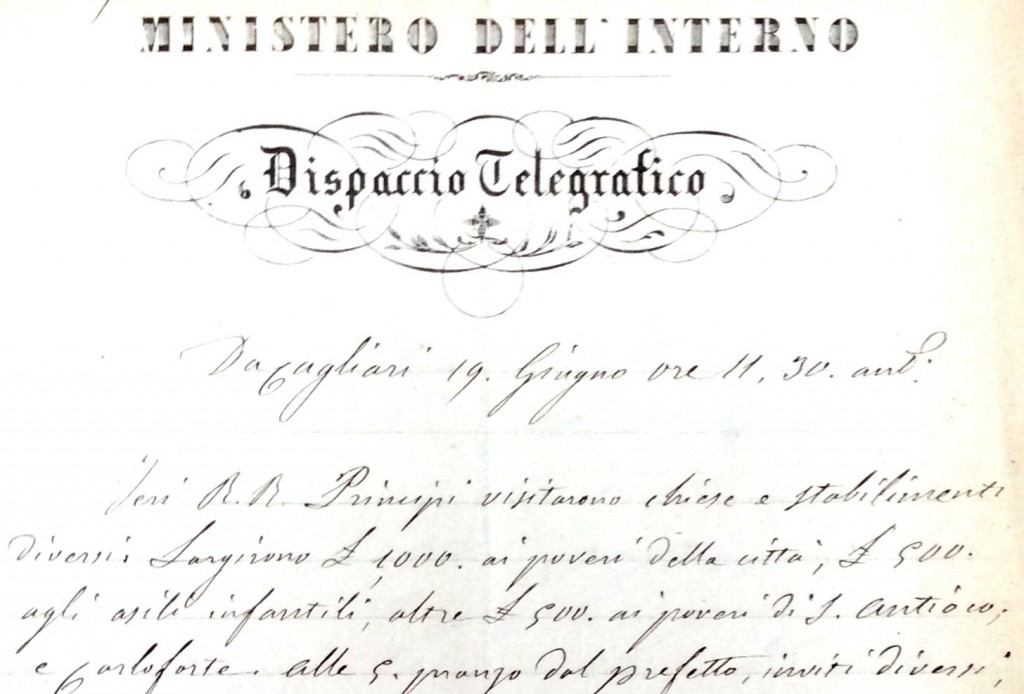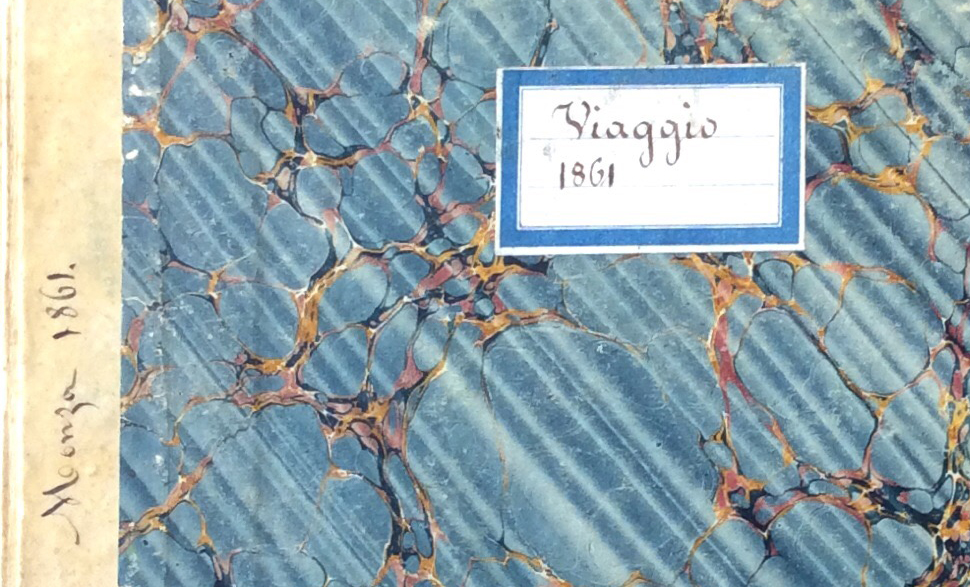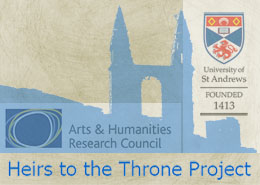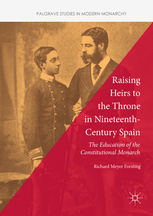Princes on the Road 
Maria-Christina Marchi
‘1861, September 16, Monday: Monza, Milan and Desenzano.
His Majesty having granted his sons the permission to travel in order to visit the battlegrounds at San Martino, Emilia, Umbria, the Marche and Toscana, the Royal Highnesses, accompanied by their Governatore, Cav. Rossi, and by the Ufficiali d’ordinanza, Sir Perrone, Knight of San Marzano, as well as by Professor Sismonda, set off from Monza at 4 ¼ a. m. on the sixteenth by carriage so as to reach the train station that leads from Milan to Desenzano. They met SE General La Marmora, Count Pasolini, Sir Beretta and Colonel Bariola at the jetty, whose job it was to accompany the Royal Highnesses to the battlefield of San Martino and narrate to them that great day which bestowed much glory on our armies.’
This note, written by one of their attendants, chronicles the journey the princes undertook to visit recently annexed provinces in the wake of Italian unification. Crown Prince Umberto (1844-1900) and his brothers Amedeo (1845-90) and Oddone (1846-66)* had suddenly become princes in a much larger kingdom that was composed of regions wholly unknown to them. Umberto in particular, as heir to these new lands, needed to gain better knowledge of the various cultures and regions – and the people living there should become more familiar with their new royal family and especially with their future king. Loyalty to the new monarchy was a central objective in the years after unification, and the king was made the centrepiece of the Risorgimento myth – alongside the military hero Giuseppe Garibaldi and the charismatic republican thinker Giuseppe Mazzini. The Crown was part of this ‘holy trinity’ which had ‘liberated’ Italy from the tyrannous rule of the Bourbons and the oppressive regime of the Pope. The narrative built around Vittorio Emanuele, father of the fatherland, was crucial to the effort to unite the country more deeply than mere geographical boundaries could. The Crown, it was thought, was the only power with which all inhabitants were familiar, a possible force of cultural unification. Many members of the government believed in the powerful symbolism that the Crown could provide, for, as Prime Minister Francesco Crispi, a Sicilian, famously put it, ‘monarchy unites us’.
One of the most effective ways to make the Savoia dynasty a central point of national identification was for the princes to set out on ‘educational’ trips, and show themselves to the population. It would allow for people from all social backgrounds to develop an interest in the new royal family, help legitimise the Savoia’s claim in Italy, and also demonstrate that the monarchy aimed to be in touch with its people. The wording of the Savoyard constitution had been changed from proclaiming Vittorio Emanuele King ‘by the Grace of God’ to proclaiming him King of Italy ‘by the Grace of God and the Will of the People’ – a claim that the Crown intended to use in order to gain popular support in the years following unification. Thus, sending the princes on a journey across a large portion of the newly annexed regions, especially the areas that had, until recently, formed the Papal State, was strategically important: It generated legitimacy and popularity, as well as allowing the princes to broaden their knowledge of unified Italy and see the world beyond Piedmont.
During the nineteenth century the concept of royal travel – reminiscent of travelling courts of the medieval period – was being revived in many parts of Europe. In Italy, the act of royal personages literally approaching their subjects rather than having them come to the royal sphere, marked the beginning of an elaborate strategy designed to make the monarchy the central focus of Italianness. Although documents dating from 1853 show that the Savoy princes had travelled throughout Piedmont in a very similar manner, collecting poetry and gifts along the way from their subjects, the change in scale and in aim of these tours meant that their purpose was not only to remind people of the Crown, but to consolidate its presence throughout the country.
The importance of the princes’ post-Risorgimento journey in 1861 was highlighted by its magnitude and its careful documentation, which stressed the educative value of the trip – both for the princes and the people they were visiting. The train with the royal party would stop at each of the bigger stations, like Bergamo and Brescia, where the exalted travellers briefly met with the authorities. In Brescia the city’s governor, Commendadore Natoli, ‘asked for the honour of accompanying the royal princes to Desenzano’.
In Desenzano, their first official stop, the princes were greeted by the mayor, the city council, the parish priest and a ‘great crowd of people’ – an important fact for a monarchy that was trying to build up its popularity in the newly annexed territories. In the evening the princes dined with the most important local figures, including nobles and the head of the local Carabinieri, in order to instil a sense of rapport with the ruling elites. Moreover, the princes’ visit to the battlefield of Solferino and San Martino was charged with symbolic importance: The victory of Solferino, where the allied French and Sardinian armies had won a decisive battle during the Second Italian War of Independence in 1859, had been an important step towards Italian unification.
This first visit set the military tone of their entire trip. The next stop, Montechiari on 17 September 1861, featured a military manoeuvre of the sixteenth division, which was led by General La Marmora, a hero of the Risorgimento battles, celebrated both in the north and in the south. In S. Lorenzo a Torri the town’s population as well as the National Guard welcomed the guests with the royal fanfare. Here they visited the Picenardi Villa, home of the Marchese Araldi, where a commemorative stone was unveiled in honour of one of Vittorio Emanuele’s ministers, Luigi Count Cibrario. Various aspects of royal duty were compressed into each visit: Military display as well as cultural and commemorative occasions allowed the princes to engage with different facets of their role and demonstrated their ‘interests’ in a broader spectrum of the population, from soldiers, to intellectuals, to children.
The narration of their journey is very detailed. In each town they were received by the mayor and the most powerful local figures; they were acclaimed by the crowds and shown a military parade. In return the princes rode around the town in their carriage. Their visits were all similar in style and it was made sure that the princes would dedicate enough time to each stop, bestowing on it the royal experience.
Their stop in Borgo San Martino on 23 September was fairly typical:
‘In Borgo San Martino the kings’ sons were met by Rimini’s governmental authorities, who escorted them all the way to the gates of the city where they were then received by the Mayor amongst the cheers of the citizens and the harmonies of the Republic of San Marino’s musical band, and they accompanied them with great fanfare to their destination, the Hotel della Spada. From their room the princes watched the National Guards’ march by, and all of the authorities (bar the ecclesiastical ones) paid the troops homage.’
This example not only reveals the princes’ level of involvement in the events and their heightened visibility; it also highlights the rift between the new monarchy and the church – a rift that was less visible in the north, when they were received by the local parish priest in Desenzano. The second part of the journey took the princes into what would have previously been part of the Papal States. The loss of those territories had enraged Pius IX and ultimately resulted in the king’s excommunication from the Catholic Church. Consequently, priests and members of the clergy had been encouraged to abstain from political involvement in the new kingdom.
The narrative thus reveals that those involved in government and with the Crown were aware of the problems that beset the new kingdom, and the fact that these are picked up by the author, shows that there was an attempt to deal with them by popularising the image of the young princes. Moreover, the awareness that the Church was not going to be available as a nationalising tool, helped to develop a strategy aimed at a secular ersatz religion: the Crown. Faith was one thing that all Italians had in common, but because of the stand the Vatican had taken against the monarchy, unity had to be sought elsewhere. The Crown, with its ‘liberal’ ways and heroic identity, seemed a plausible choice.
Moreover, the cultural as well as commemorative events that marked the princes’ journey demonstrated the desire to ‘invent tradition’ and link the Savoia name to a local history, which was slowly being nationalised. For example, during their stop near Pavia, the princes visited the rooms were Francis I of France had stayed during the Battle of Pavia in 1725. Strictly speaking, this could be interpreted as an act of homage to an ‘invader’ of Italy. Instead, the visit represented a kind of continuity between the rulers of the past and those of the present. History was appropriated by the Savoia and turned into an ‘Italian’ tradition, rather than maintaining its local character.
In 1862 the princes went on the road again, but this time they visited the Southern regions not touched during their first official tour. According to a letter dated 31 May 1862, all three princes were to visit Sardinia, Sicily and the Neapolitan provinces. They basically retraced Garibaldi’s steps during the Expedition of the Thousand in 1860. After setting off from Genova – just like the revolutionary and his band of volunteers – they made their way to Sicily, stopping in Sardinia to greet their old subjects, since Sardinia had always been a part of the old Savoia kingdom.

Extract from a telegraphical dispatch from the 1862 journey (Archivio di Stato di Torino, Sezione Corte)
There is no overall narrative account for this trip, however telegrams regularly sent to Turin document the journey. Like on their first tour the princes attended a mixture of military and cultural events. There were also a few innovations, such as the giving of prizes at competitions and acts of charity. In Sardinia they gave L. 1,000 to the poor as well as L. 400 to the local nursery. The princes were ‘welcomed everywhere with applause and with enthusiastic evviva… military bands, roads covered in flags and flowers…’ Overall, it sounded like their visits were both appreciated by the local populations and served as successful media exploits. The press coverage of royal events, such as the royal wedding between Umberto and Margherita in 1868, would emerge as a crucial way of propagating the popularity of the crown, with articles which promoted loyalty to the ruling family. Reports of events such as the royal visits of 1861 hid the unstable political situation and violent clashes in the southern parts of the peninsula and directed the public gaze at the monarchy instead.
For the princes themselves this trip was designed as explicitly educational; it also took the princes beyond Italy in an attempt to kick-start their international formation. The princes visited Constantinople, Smyrna, Rhodes, Cyprus, Syria, Egypt and the cities of Tripoli and Tunis. This extended itinerary was chosen to allow the princes mental and cultural growth. Like in many other royal families in Europe, experiences abroad were seen as key to the education of any royal prince.
Thus both trips illustrate how the strategy concerning the public image of the princes developed and how they came to serve as a symbolic representation of a charismatic monarchy, detached from party politics and mainly interested in the welfare of its people. The decision to send the princes on these journeys together demonstrated an effort to bring the Crown closer to the people and use it to bridge the gap between the new ‘legal’ Italy – an Italy managed and created by the government – and its acquired populations. It also helped consolidate the longevity of the dynasty and reinforced the notion that they were intrinsically connected to the people. Although neither the diary nor the telegrams explicitly state this plan, an underlying desire to understand the new regions and to put the princes in touch with the various cultures and people shines through their carefully planned itineraries and the constant obligation of the princes to engage with the people as personally as possible.
Overall, these travels reflect a cultural strategy aimed at the development of a sense of italianità – the innate Italian-ness everyone possessed but which needed to be shaped – through the Crown, and more specifically through the princes, was taking shape right from the beginning of Italy’s existence as a unified kingdom. Umberto, Amedeo and Oddone had to be ready to lead this new country, but more importantly, the people were given the chance to get in touch with royalty and meet them first hand. The Crown attempted to appear more accessible. As political commentator Angelo Camillo de Meis pointed out in his pamphlet The Sovereign, in order for the monarchy to survive it had to modernise and ‘a modern monarch is he who can think what the public thinks’ and whose dynasty is ‘liberal and unifying’. To a certain extent this is what the Savoia were trying to achieve – or at least, this was the image of themselves that they were trying to propagate, and royal travels, such as those undertaken by the princes, were only the first step towards this new monarchical modernity.
Further Reading
- Brice, Catherine, ‘I Viaggi della Regina Margherita’, in: Altrove: Viaggi di donne dall’antichità al Novecento Dinora Corsi, ed. (Roma: Viella, 1999), 201-19
- Cannadine, David and Price, Simon, ‘Introduction’, in: Rituals of Royalty: Power and Ceremonial in Traditional Society (Cambridge: Cambridge University Press, 1987), 1-20
- Körner, Axel, ‘The Middle Class and the Historicising of the Present’, in: Politics of Culture in Liberal Italy (New York: Routledge, 2009), 87-102
- Ridolfi, Maurizio and Tesoro, Marina, ‘Fare gli italiani: il re sulla scena’, in: Monarchia e Repubblica: Istituzioni, cultura e rappresentazioni politiche in Italia (1848-1948), (Milano: Pearson Italia, 2011), 9-14
* In the text the author always refers to ‘the princes’ yet he never calls them by name. According to other sources Umberto and Amedeo were definitely present, but it is hard to understand whether Oddone travelled with his brothers. Since his health was precarious, his presence cannot be assumed with certainty.
|
Princes’ Itinerary, September – October 1861 |
|
|
16 September |
Monza to Desenzano |
|
17 September
|
Desenzano to Montechiari, Castiglione and Cremona |
|
18 September |
Cremona |
|
19 September |
Cremona to Crema and Lodi |
|
20 September |
Lodi to Bologna |
|
21 September |
Bologna to Ferrara and back |
|
22 September |
Bologna to Imola, Faenza and Ravenna |
|
23 September |
Ravenna to Rimini |
|
24 September |
Rimini to Pesaro and Ancona |
|
25 September |
Ancona |
|
26 September |
Ancona to Jesi |
|
27 September |
Jesi to Castelfidardo and Loreto |
|
28 September |
Loreto to Macerata, Tolentino and Foligno |
|
29 September |
Foligno to Trevi, Spoleto, Terni, Piediluco and Terni |
|
30 September |
Terni to Spoleto, Assisi and Perugia |
|
1 October |
Perugia |
|
2 October |
Perugia to Foligno and Urbino |
|
3 October |
Urbino to Fossombrone, Fano and Pesaro |
|
4 October |
Pesaro to Rimini and Bologna |
|
5-8 October |
Bologna |
|
9-12 October |
Firenze |
|
13 October |
San Rossore |
|
14 October |
San Rossore to Pisa, Viareggio, Pisa and Firenze |
|
15 October |
Firenze to Livorno |
|
16 October |
Livorno to La Spezia, Genova and Moncalieri |
|
Princes’ Itinerary, 1862 |
|
|
Sardinia
|
Island of the Maddalena, Porto Torres, Sassari, Alghero, Oristano and Cagliari |
|
Sicily |
Touching the main ports along the coast, such as Palermo, Trapani, Grigenti, Siracusa and Messina |
|
Naples
|
Following the coast and stopping in Reggio and Taranto |
|
Turkey |
Constantinople and Smyrna |
|
Rhodes and Cyprus |
|
|
Syria
|
Tripoli, Beirut, St John of Airi, Jaffa and a trip to Jerusalem |
|
Egypt |
Alexandria, Cairo and Suez |
|
Barbareschi States |
Tripoli and Tunis |
|
return to Genoa |
|









